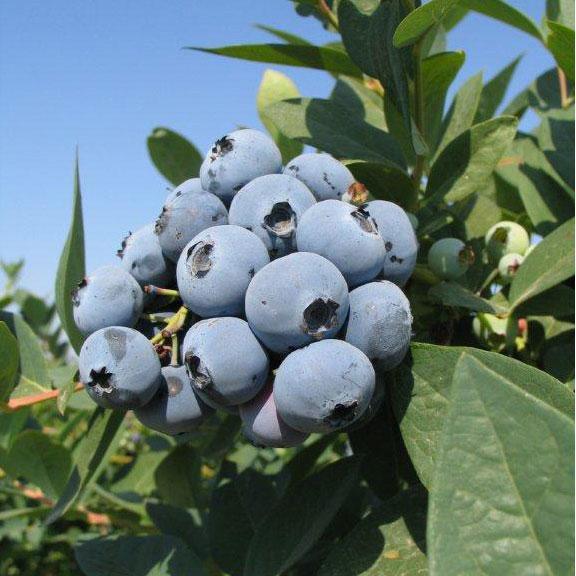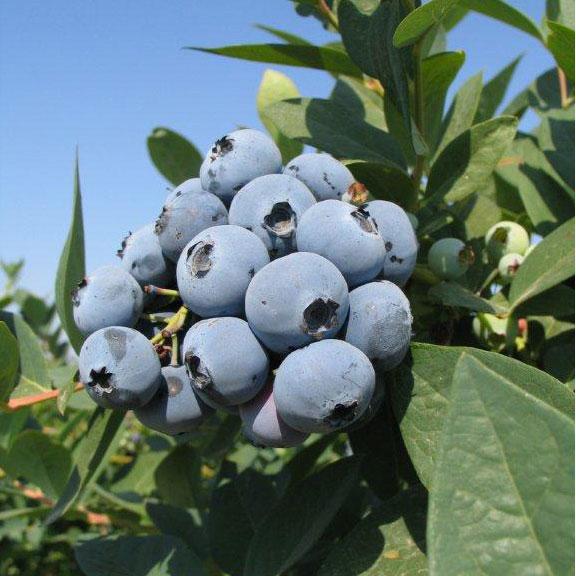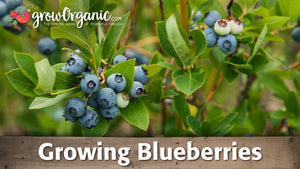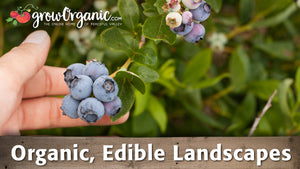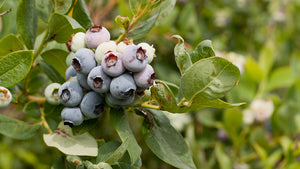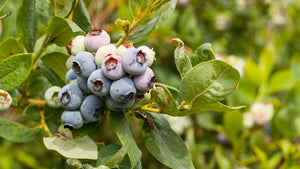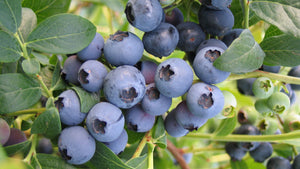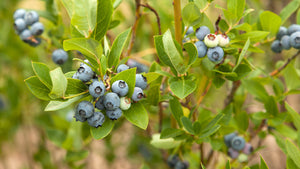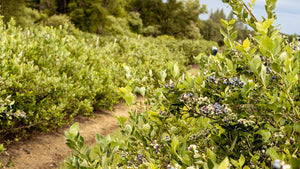Item Number: FV374
Blueberry - Jewel (Early Mid-Season)
Blueberry - Jewel (Early Mid-Season)
Yields Abundant Crops
- Latin Name: Vaccinium corymbosum sp.
- Variety: Southern Highbush
- Plant Age: 1.5 years
- Zones: 8-10
- Chill Hours: 200
- Harvest: Early mid-season
- Bush Habit: Upright bush reaching 6 – 8' tall with green foliage in fall.
- Fruit: Very large, tangy berries.
- Facts of note: Jewel yields abundant crops of the largest Southern Highbush berries with a tangy flavor. Its upright habit makes it a great landscape plant. Dependable in mild-winter climates because of a low chill requirement. Long harvest period. Plant with other mid-season fruiting blueberries for best performance.
Introduction to the Jewel Blueberry
The Jewel Blueberry, scientifically known as Vaccinium corymbosum 'Jewel,' is a popular cultivar of blueberry prized for its delicious flavor, versatility, and vibrant appearance. In this article, we will delve into the characteristics, cultivation requirements, and benefits of growing the Jewel Blueberry in your home garden or orchard.
Characteristics of the Jewel Blueberry
Size and Shape The Jewel Blueberry is a deciduous shrub that typically reaches a height of 4-6 feet, with a similar spread. It boasts an upright and compact growth habit, making it well-suited for both small and large garden spaces. The plant forms an attractive, dense canopy of green foliage during the growing season, which transitions to stunning fall foliage in shades of red and orange.
Fruit The primary allure of the Jewel Blueberry lies in its abundant, large, and delectable berries. These berries are typically medium to dark blue, showcasing a rich, jewel-like appearance that lends the cultivar its name. Jewel Blueberries are known for their exceptional flavor – sweet, with a subtle hint of tartness – making them perfect for fresh consumption, baking, and preserving.
Ripening Season The Jewel Blueberry is a mid to late-season cultivar, with fruit typically ripening in late June to July, depending on your geographic location. Its extended harvesting season provides an opportunity for an extended period of enjoyment and ample harvest.
Cultivation Requirements
Sunlight Jewel Blueberries thrive in full sun to partial shade. To maximize fruit production, it's essential to provide them with at least 6-8 hours of direct sunlight daily. However, they can tolerate a bit of afternoon shade in warmer regions.
Soil These blueberries prefer well-drained, acidic soil with a pH level between 4.5 and 5.5. It's crucial to ensure proper soil preparation by amending the soil with organic matter like compost or peat moss to improve moisture retention and acidity.
Watering Maintaining consistent moisture is key to successful Jewel Blueberry cultivation. Ensure that the soil remains consistently moist, especially during the fruiting season. Mulching around the base of the plant can help retain moisture and reduce weed competition.
Pruning Pruning is essential to maintain the health and productivity of Jewel Blueberries. Regularly remove dead or diseased branches and conduct yearly pruning in late winter to promote vigorous growth and fruit production. It's also recommended to thin out crowded branches to improve air circulation.
Benefits of Growing Jewel Blueberries
Health Benefits Jewel Blueberries are not only a delight to the taste buds but also a nutritional powerhouse. They are packed with antioxidants, vitamins, and fiber, contributing to better overall health. Regular consumption of blueberries has been linked to improved cognitive function, heart health, and reduced risk of chronic diseases.
Versatility in Culinary Use These blueberries are versatile in the kitchen and can be used in a variety of culinary creations. Enjoy them fresh as a snack, toss them in salads, blend them into smoothies, or use them in baking and desserts. Their vibrant color also makes them an attractive garnish.
Ornamental Appeal Beyond their fruit-bearing capabilities, Jewel Blueberries enhance the aesthetic of any garden with their attractive foliage and vibrant fall colors. They make an excellent addition to ornamental and edible landscapes.
The Jewel Blueberry is a prized cultivar for any home gardener or orchard enthusiast. With its delightful flavor, ease of cultivation, and health benefits, it's no wonder that the Jewel Blueberry is a favorite among blueberry aficionados. Whether you're a seasoned gardener or a beginner, growing Jewel Blueberries can be a rewarding and fruitful endeavor.
For more information, please enjoy our Growing Guide for planting and growing blueberries.


Check Your Zone Compatibility:
Compatible with your zone.
Growing Zone for
,

Our Guarantee To You
Since 1976, we've served our customers at every stage of growing. Please contact us at any time. We are happy to support and assist you.
Description
Description
- Latin Name: Vaccinium corymbosum sp.
- Variety: Southern Highbush
- Plant Age: 1.5 years
- Zones: 8-10
- Chill Hours: 200
- Harvest: Early mid-season
- Bush Habit: Upright bush reaching 6 – 8' tall with green foliage in fall.
- Fruit: Very large, tangy berries.
- Facts of note: Jewel yields abundant crops of the largest Southern Highbush berries with a tangy flavor. Its upright habit makes it a great landscape plant. Dependable in mild-winter climates because of a low chill requirement. Long harvest period. Plant with other mid-season fruiting blueberries for best performance.
Introduction to the Jewel Blueberry
The Jewel Blueberry, scientifically known as Vaccinium corymbosum 'Jewel,' is a popular cultivar of blueberry prized for its delicious flavor, versatility, and vibrant appearance. In this article, we will delve into the characteristics, cultivation requirements, and benefits of growing the Jewel Blueberry in your home garden or orchard.
Characteristics of the Jewel Blueberry
Size and Shape The Jewel Blueberry is a deciduous shrub that typically reaches a height of 4-6 feet, with a similar spread. It boasts an upright and compact growth habit, making it well-suited for both small and large garden spaces. The plant forms an attractive, dense canopy of green foliage during the growing season, which transitions to stunning fall foliage in shades of red and orange.
Fruit The primary allure of the Jewel Blueberry lies in its abundant, large, and delectable berries. These berries are typically medium to dark blue, showcasing a rich, jewel-like appearance that lends the cultivar its name. Jewel Blueberries are known for their exceptional flavor – sweet, with a subtle hint of tartness – making them perfect for fresh consumption, baking, and preserving.
Ripening Season The Jewel Blueberry is a mid to late-season cultivar, with fruit typically ripening in late June to July, depending on your geographic location. Its extended harvesting season provides an opportunity for an extended period of enjoyment and ample harvest.
Cultivation Requirements
Sunlight Jewel Blueberries thrive in full sun to partial shade. To maximize fruit production, it's essential to provide them with at least 6-8 hours of direct sunlight daily. However, they can tolerate a bit of afternoon shade in warmer regions.
Soil These blueberries prefer well-drained, acidic soil with a pH level between 4.5 and 5.5. It's crucial to ensure proper soil preparation by amending the soil with organic matter like compost or peat moss to improve moisture retention and acidity.
Watering Maintaining consistent moisture is key to successful Jewel Blueberry cultivation. Ensure that the soil remains consistently moist, especially during the fruiting season. Mulching around the base of the plant can help retain moisture and reduce weed competition.
Pruning Pruning is essential to maintain the health and productivity of Jewel Blueberries. Regularly remove dead or diseased branches and conduct yearly pruning in late winter to promote vigorous growth and fruit production. It's also recommended to thin out crowded branches to improve air circulation.
Benefits of Growing Jewel Blueberries
Health Benefits Jewel Blueberries are not only a delight to the taste buds but also a nutritional powerhouse. They are packed with antioxidants, vitamins, and fiber, contributing to better overall health. Regular consumption of blueberries has been linked to improved cognitive function, heart health, and reduced risk of chronic diseases.
Versatility in Culinary Use These blueberries are versatile in the kitchen and can be used in a variety of culinary creations. Enjoy them fresh as a snack, toss them in salads, blend them into smoothies, or use them in baking and desserts. Their vibrant color also makes them an attractive garnish.
Ornamental Appeal Beyond their fruit-bearing capabilities, Jewel Blueberries enhance the aesthetic of any garden with their attractive foliage and vibrant fall colors. They make an excellent addition to ornamental and edible landscapes.
The Jewel Blueberry is a prized cultivar for any home gardener or orchard enthusiast. With its delightful flavor, ease of cultivation, and health benefits, it's no wonder that the Jewel Blueberry is a favorite among blueberry aficionados. Whether you're a seasoned gardener or a beginner, growing Jewel Blueberries can be a rewarding and fruitful endeavor.
For more information, please enjoy our Growing Guide for planting and growing blueberries.
About Blueberries: Delicious, exceptionally nutritious, and high in bioflavanoids. Consider climate suitability, ripening season and fruit size when selecting varieties and include at least two different varieties for cross-pollination and fruiting (any two varieties will do, regardless of ripening time). Grow in acidic, well-drained soil. Cottonseed meal is an excellent fertilizer for blueberries along with good quality compost and peat moss.
Browse our collection of blueberries.
Shipping Information
Shipping Information
Cannot ship to the following states: HI, AK, PR, GU, VI
Cannot ship via USPS.
Cannot ship via SmartPost.
Shipping Weight: 3.0 lb
Dimensions: 14.0"L x 3.0"W x 3.0"H
Features
Features
- Container Compatible
- Long-Lived
- Suited to Warmer Climates
Characteristics
Characteristics
Planting & Care
Planting & Care
Useful Information
Useful Information
Guarantee
Guarantee
Limited Dormant Tree & Plant Guarantee
* Claim deadline is June 15th
We guarantee that your dormant tree or plant will arrive in good, viable condition. If your tree arrives in substandard condition, notify us within 3 days of delivery. Please email pictures of the box, inside packaging, the tree and its roots to helpdesk@groworganic.com. We will investigate your claim and process a request to exchange or refund the damaged product.
If your dormant tree or plant has not grown new leaves by June 15th, you may be eligible for our Limited Dormant Tree & Plant Guarantee. This guarantee provides for a store credit for the purchase price of the tree, excluding shipping. Please see the Instructions below.
Important Dates:
- April 1st Dormant trees/plants must be planted in the ground
- May 15th Perform scratch test, if no new leaves have grown
- June 15th Deadline to apply for a dormant tree/plant credit
All required documentation must be received by June 15th for your claim to be considered. Claims or documentation received after June 15th will be denied, without exception. Instructions listed below
Terms and Conditions
We cannot guarantee that your tree or plant will remain alive and healthy after it is received, or bear fruit as there are too many variables in your environment that are beyond our control (i.e. soil preparation, weed and pest control, proper irrigation, chill hours, compatible hardiness for your growing zone, proper choice of pollinator, extreme weather, rodent damage, disease, etc.).
We cannot guarantee that we will be able to provide a replacement tree/plant of the same species either that same growing season or in future years. Customers are responsible for all shipping fees associated with replacement trees and plants.
If we determine that the tree you purchased directly from us is not viable, we will issue you a store credit (not a refund) for the purchase price of the affected dormant tree or plant. Shipping is not included in the dormant tree/plant guarantee. Store credits can be used to purchase any product we sell and are valid for use only until July 1st of the following year.
Historically, 98% of our dormant trees and plants grow and thrive when they have been cared for and planted using our growing guides. Dormant trees and plants must be planted in the ground by April 1st in order to be eligible for credit. If the ground in your area is still frozen solid, you may temporarily plant your tree or plant in a pot.
Potted, non-dormant trees or plants are excluded from this guarantee as they are not dormant at the time of shipment. Evergreen trees such as citrus, avocado and olive trees are not available for credit under the Dormant Tree and Plant Guarantee.
Instructions
We guarantee that your dormant fruit tree or plant will leaf out, if you care for it according to our growing guides. In the unlikely event that your dormant tree or plant does not have leaves by May 15th, follow these simple steps to apply for a store credit:
Before you call or email, please perform a “scratch test” to determine if the tree or plant is still alive. This video shows how to check for live tissue under the bark. Scratch tests need to be done a few inches above and below the graft.
Green Cambium Layer / Living Trees
If the cambium layer under the bark is green, give your tree a little more time. It is still alive, but hasn’t come out of dormancy yet. Check to make sure that it is getting the right amount of deep root water, enough sunlight and that the weather is warm enough for that type of tree/plant to come out of dormancy. Every tree has its own personality and will come out of dormancy at different times. Be sure to submit the required documentation listed below by June 15th, if it doesn’t grow leaves.
Brown Cambium Layer / Dead Trees
If the scratch test shows a brown cambium layer or if your dormant tree/plant doesn’t have leaves by June 1st, please email us at helpdesk@groworganic.com. All required documentation listed below must be received by June 15th for your claim to be considered. To be considered for the guarantee claim, all required documentation must be received by June 15th. Incomplete submissions will be denied.
Required Documentation
- Order number
- Name of dormant tree/plant and the quantity affected
- Photos of each tree or plant showing:
- The roots (tree or plant must be pulled out of the ground)
- The scratch test areas
- The entire tree/plant
We reserve the right to not issue credit for items that have already been replaced. We also reserve the right to require photographic evidence that the tree/plant was not killed by root rot, rodent or mechanical damage.
Share
